What is Measles in Children?
Measles in children is a highly contagious viral infection that primarily affects kids under five. It spreads through droplets in the air when an infected person coughs or sneezes. The illness starts with flu-like symptoms and quickly progresses to a distinct red rash. Despite the availability of effective vaccines, recent outbreaks highlight the ongoing threat, especially in communities with low immunization rates.
Signs and Symptoms of Measles in Children
Early detection of measles in children is key. Typically, symptoms appear 10–14 days after exposure and may include:
- High fever (can reach above 104°F or 40°C)
- Cough and runny nose
- Red, watery eyes (conjunctivitis)
- Koplik spots (white lesions inside the cheeks)
- Red, blotchy rash that starts on the face and spreads downwards
As the illness progresses, the rash eventually darkens or turns hyperpigmented, especially in darker skin tones.
How Doctors Diagnose Measles in Children
Doctors confirm a measles diagnosis by evaluating both clinical symptoms and lab tests:
- They look for fever, cough, coryza, conjunctivitis, and rash
- They perform blood tests to detect measles-specific IgM antibodies
- They may run RT-PCR to identify measles RNA
Clinicians in resource-limited settings often rely on visible signs like hyperpigmented rash, fever, and respiratory symptoms to make a presumptive diagnosis.
Complications of Measles in Children
Although many children recover, measles in children can lead to severe complications. In particular, children under five, immunocompromised individuals, and malnourished children face the highest risk.
Common complications include:
- Pneumonia
- Diarrhea
- Ear infections
- Croup
- Encephalitis (brain inflammation), which may prove fatal
Children undergoing cancer treatment face even greater danger. They may not develop a rash, and their illness can quickly escalate to giant cell pneumonia.
How to Treat Measles in Children
Although doctors can’t cure measles with antivirals, they manage it through supportive care. For example:
- Encourage adequate fluid intake to avoid dehydration
- Use paracetamol or ibuprofen to control fever and improve comfort
- Administer vitamin A supplementation—two high doses of 200,000 IU—to help reduce mortality, especially in children under two
Doctors may also prescribe antibiotics to treat secondary infections like bacterial pneumonia.
Preventing Measles in Children
Parents can protect their children most effectively through vaccination:
- Schedule the first dose of the MMR vaccine at 12–15 months
- Follow up with the second dose at 4–6 years
These two doses provide 97% protection, while one dose offers 93% effectiveness.
Parents should also:
- Make sure all family members receive full vaccination
- Help protect infants by promoting herd immunity
- Speak with a doctor about post-exposure prophylaxis if someone in the household gets exposed
Combating Vaccine Hesitancy and Responding to Outbreaks
Despite the effectiveness of vaccines, outbreaks still happen due to misinformation and travel-related exposure.
Public health officials encourage communities to:
- Educate families about the safety and necessity of vaccines
- Enforce school-entry immunization checks
- Launch mass immunization campaigns during outbreaks
These actions help curb the spread and protect vulnerable populations.
When Should You Seek Medical Help?
Parents should reach out to a healthcare provider right away if their child:
- Develops a high fever and rash
- Shows signs of breathing problems, persistent vomiting, or confusion
- Has a weakened immune system and comes into contact with measles
Quick action can prevent serious complications and save lives.
Why This Still Matters Today
Although measles has become less common in some parts of the world, it remains a persistent and preventable threat to children’s health. Because the virus spreads so easily and causes severe complications, parents and caregivers must stay informed and proactive. The ongoing resurgence of measles in certain areas underscores the importance of high immunization rates and strong public health policies.
Final Thoughts on Measles in Children
While measles in children may sometimes resolve without serious consequences, it remains a global public health challenge. For this reason, vaccination, public education, and timely medical care play vital roles in preventing new outbreaks and protecting children everywhere.
This version has been updated to reduce passive voice and enhance clarity, while preserving factual accuracy and readability.
The following posts may interest you
Autism: Understanding Signs, Causes, and Support Options
Understanding and Managing Diabetes in Children
Sources:
Measles in children who have malignant disease
https://www.bmj.com/content/295/6589/15.abstract
Vitamin A for treating measles in children
https://www.cochranelibrary.com/cdsr/doi/10.1002/14651858.CD001479.pub3/abstract
Principles of measles control
https://pmc.ncbi.nlm.nih.gov/articles/PMC2393212
Measles: a disease often forgotten but not gone
https://www.hkmj.org/system/files/hkmj187470.pdf
An evaluation of the clinical features of measles virus infection for diagnosis in children within a limited resources setting

